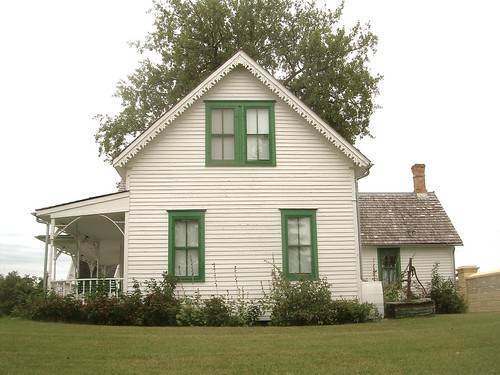With a population of just over 50,000, Grand Forks is the third largest city in North Dakota, and the Greater Grand Forks area, including East Grand Forks across the river in Minnesota, tops 100,000. While the history of Grand Forks goes back to its founding in 1870, the area upon which it was built on the western banks of the Red River of the North, which once served as a Native American trading location, has a much longer history that dates back thousands of years. For everyone who calls this area home, there are several unique historical sights to see.
Grand Forks County Historical Society

The Grand Forks County Historical Society has restored several historic houses and is dedicated to preserving the artifacts and significant documents of post-Colonial Grand Forks. The Society is headquartered at 2405 Belmont Road on the grounds of the Thomas D. Campbell House, which was its first restoration project. This house started as a log cabin built by Thomas and Almira Campbell, who were homesteaders in 1875, then it was upgraded to a Gothic Revival-style house in the 1890s. Along with its land, it was donated, restored, and opened by the Historical Society in 1971.
Over the years, more historic buildings have been moved onto the grounds or, like the Myra Museum, built on-site to house the Society’s collections. Grand Forks’ oldest building, the original Post Office, can be found here, as well as the more recent Lustron House, which was designed after the steel-fabricated homes of the post-WWII era. The Myra Centennial Pavilion was added in 1989 and can be rented for weddings, and it serves as an outdoor gathering venue for summer concerts. Admission is $8 for adults and $5 for children.
Heritage Foundation Village in East Grand Forks
If you venture across the river into Minnesota, you’ll find East Grand Forks, Grand Forks’ twin city. Here you can visit the Heritage Foundation Village, which brings the history of the Northern Red River Valley in the mid-1800s through the early 1900s to life with its collection of pioneer buildings. You can participate in tours as well as hands-on educational programs and presentations. This village is even available for weddings, in case you’d like to tie the knot at a historic landmark. The Heritage Foundation Village is located on 20 Street NE across from the technical college.
Historic buildings that were either moved or built here include the Amundson Barn, which is a large red barn that was built in 1918 and moved to its current location in 2005; a general store in the original Hanson-Maves building that was built in 1902; the Granville Church, which was built in 1895 and is one of the oldest churches in the area; a sawmill; a blacksmith’s shop; and a landmark log schoolhouse from the 1800s. The Nisbet Farmstead, which includes a log cabin, barn, and granary from the early 1870s, can also be toured.
Turtle River State Park
Turtle River State Park is located about a half-hour directly west of Grand Forks and was built by the Civilian Conservation Corps in the 1930s. Here, the heritage of the local forest valley and land along Turtle River is preserved in a protected space that can be enjoyed through many activities, including mountain biking, skiing, picnicking, hiking, camping, and cabin rentals. It features more than 12 miles of trails through woodlands and alongside the river, and there are several facilities like the Woodland Lodge, which has a kitchen and dining hall and is available to rent for weddings, groups, and family gatherings.
Prices start at $7 for a vehicle entrance fee and $17 for a primitive campsite and go up for modern campsites with more amenities. The Woodland Cabins are duplexes that can sleep up to six people per unit, or three people in the two handicap accessible units. The Civilian Conservation Corps Memorial Shelter also offers a beautiful wedding or event venue within the serene park. Whether you want to spend the weekend camping and fishing or just go for an afternoon hike, Turtle River Park is a great place to experience the natural heritage around you.
University of North Dakota
The historic campus of the University of North Dakota was founded in 1883, six years before North Dakota was even a state. At 521 acres, it is the largest campus in the state, and the school is a leader in engineering, medicine, and aviation. From the first graduating class in 1889 of six women and two men, it has grown to its current enrollment of over 13,000. Its historic district primarily features the Collegiate Gothic architecture style of brick exteriors, stone surrounds, arched entrances, and crenelated parapets. Why not check out these impressive buildings while strolling along the banks of the English Coulee?
R.S. Blome Granitoid Pavement
You might not think that a century-old pavement could be a historic attraction, but you’d be wrong. R.S. Blome Granitoid Pavement consists of several streets that were built in 1910 and 1911. This type of road surface was designed for both horses and automobiles and is made from a mixture of Portland cement and granite chips. In 1991, a 55-acre area of these pavements was listed on the National Register of Historic Places, but the area was decreased in 2010. You can still find this pavement on Lewis Boulevard south of Conklin Avenue and surrounding areas.
Grand Forks has a long history and many well-preserved landmarks from its past. From a historic downtown with nearly 70 buildings that date from the 1880s to the 1960s to the restored sites on this list, Grand Forks has certainly evolved through the years! Have you been to any of these historical sites around the Greater Grand Forks area? Are there any hidden treasures we’ve missed or a location you particularly loved? At Rydell Nissan of Grand Forks, we’d love to hear what you’d recommend most from around here, so drop us a line with your best suggestions!


![[Facebook]](https://www.gfnissan.com/blogs/743/wp-content/plugins/bookmarkify/facebook.png)
![[LinkedIn]](https://www.gfnissan.com/blogs/743/wp-content/plugins/bookmarkify/linkedin.png)
![[Twitter]](https://www.gfnissan.com/blogs/743/wp-content/plugins/bookmarkify/twitter.png)
![[Yahoo!]](https://www.gfnissan.com/blogs/743/wp-content/plugins/bookmarkify/yahoo.png)
![[Email]](https://www.gfnissan.com/blogs/743/wp-content/plugins/bookmarkify/email.png)
